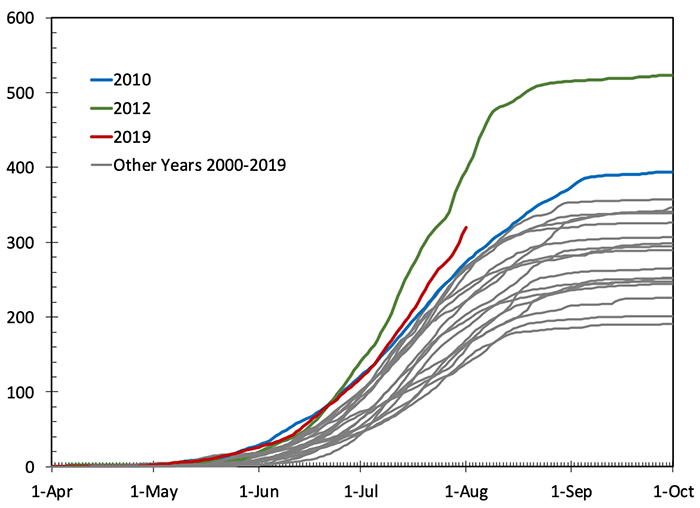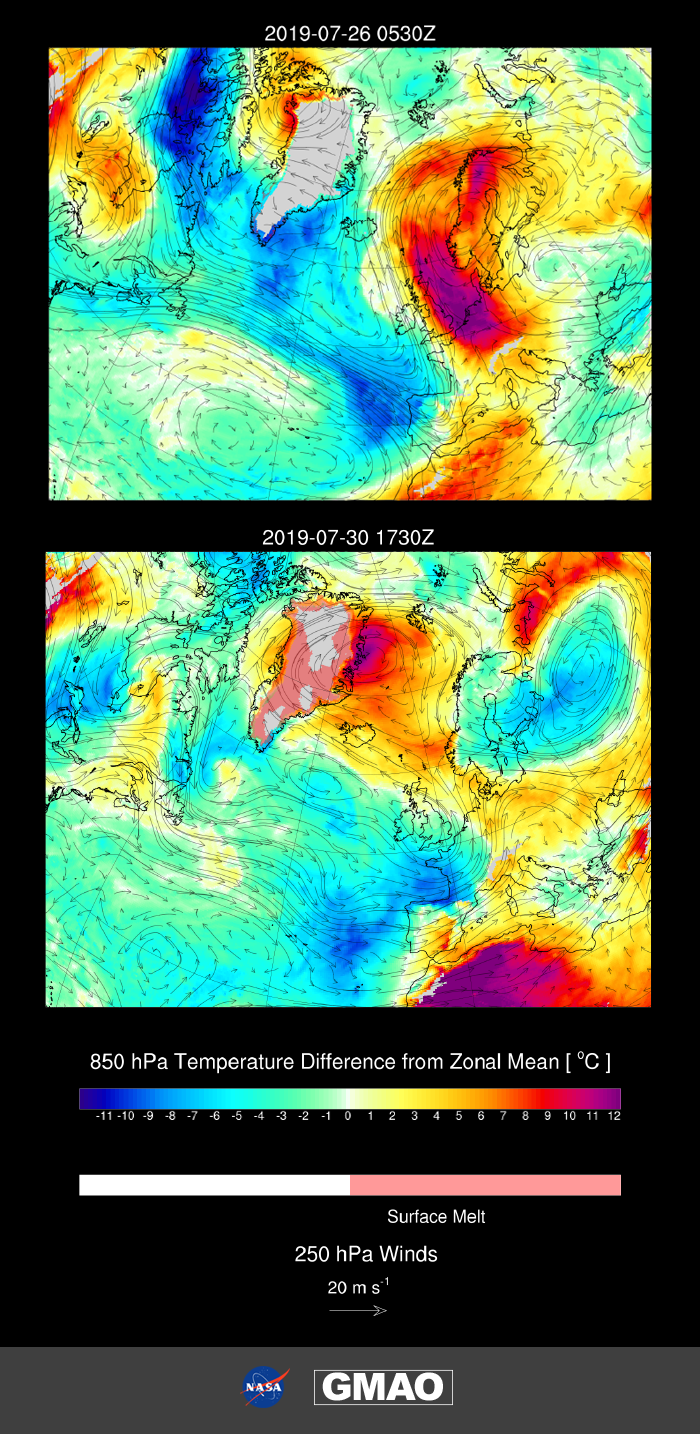Historic Greenland Ice Melt Event Follows European Heatwave
The Greenland Ice Sheet experiences surface melting each summer. But in late July 2019, the ice sheet experienced one of the most extensive melt events on record. The event triggered above-freezing temperatures across approximately 60 percent of the ice sheet, including at Summit Station — the highest point in Greenland where surface melting has only been recorded once in the last century, in 2012. This year’s event resulted in significant meltwater runoff into the ocean and altered the ice surface, making it more prone to melting in the future. Melt events on the Greenland Ice Sheet display considerable variability; therefore, predicting these events and the atmospheric conditions which lead to them can be challenging.
The NASA Goddard Earth Observing System Forward Processing (GEOS-FP) system captured the formation of a massive high-pressure dome over much of Europe and the advection of desert air from Northern Africa starting on July 22. This system persisted over Europe for several days resulting in record high temperatures across the continent. As high-pressure strengthened over Europe, a low-pressure trough to the west deepened and became negatively tilted, folding the jet stream back northwestward and pulling the warm air mass toward the ice sheet. Once the warm air and accompanying high-pressure moved across Greenland, surface air temperatures were up to 9 degrees warmer than the previous several days. While the warm air mass and temperature anomalies were focused in eastern Greenland, strong downslope winds increased surface melting in along the western side as well. However, a small-eastward moving low pressure system resulted in anomalously cool air in the southeast. The warming triggered extensive melting across the ice sheet between July 30 and August 1, adding to the already large flux of runoff occurring on the ice sheet this melt season. According to initial results from the MERRA-2 reanalysis, the volume of runoff is likely to place this melt season behind only 2012 in terms of mass loss.
The atmospheric conditions leading to this melt event were very unusual. During most events, including the large melt event in 2012, blocking high pressure over the North Atlantic Ocean pushes warm, moist air northward along the western coast of the ice sheet, triggering widespread melting along the western flank and enhanced downslope winds in the northeast. Though the atmospheric conditions leading to this melt event were atypical, the results were similar to other large melt events.
Melt produced during these events either runs off the ice sheet — immediately contributing to sea level rise, or it can be stored within the porous snow layers on the ice sheet. In both cases, this meltwater can reach the underlying bedrock and alter the motion of the ice sheet. Surface melt also removes snow cover and transforms the remaining snow and ice crystals, darkening the surface and making the ice sheet more prone to melt during future warming events. This type of positive feedback can continue to intensify melting through the remainder of the melt season.
Climate model forecasts suggest that increasing Arctic air temperatures will continue to accelerate ice sheet mass loss and affect a range of other Arctic processes, including the extent and volume of sea ice, the thawing and burning of permafrost and peat, and other land, ocean, and atmospheric processes within the Arctic system.
GMAO GEOS Animation: https://gmao.gsfc.nasa.gov/research/science_snapshots/anim/Greenland_ice_melt.mp4

Figure: Cumulative meltwater runoff from Greenland from MERRA-2 is shown for each year, 2000-2019, with selected years highlighted. The 2019 melt season (red line) is set to produce the second-largest volume of runoff in the MERRA-2 record, behind only 2012 (green line). Though only lasting a few days, melt events like those observed between 30-July and 1-August 2019 can contribute substantially to the cumulative surface mass balance loss for the Greenland Ice Sheet and can precondition the ice surface for more intense melting in the remainder of the melt season.


